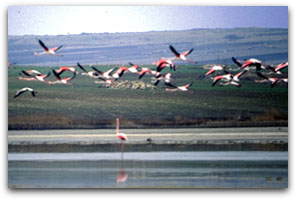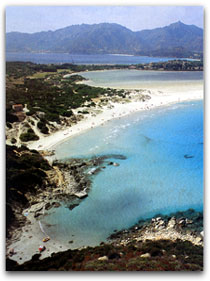
 Pink flamingos Pink flamingos |
|
Let's leave Gerrei to go towards
Sarrabus, which extends beyond the entrance to Villasimius. This area is also called " the
garden of Sardinia" because of the numerous citrus trees, luxuriantly laden with lemons,
oranges, tangerines and clementines, which thanks to its micro climate is the most productive
area in Sardinian.
|
There are many fine long beaches
in the area of Sarrabus. The river Flumendosa, which has its source in the mountains of
Gennargentu, flows into the sea here. Behind the shore of Muravera there are the stagni
(small salt water lakes) Colostrai, Feraxi and San Giovanni. In the first two ponds entire
colonies of flamingos, stilt birds and herons nest and live, in the stagno of San Giovanni a
fishermen's co-operative has developed a modern fish farm that produces oysters, mussels,
cockles and delicious fish such as dory and bass.
After Capo Ferrato, we find ourselves in front of one of the most crowded tourist areas, not only
in the province of Cagliari but in all Sardinia, the famous Costa Rei, with its very long beach.
Hotels, camping sites, residences and private houses attract many tourists every year.
Sardinia offers visitors the opportunity to eat in various farm houses the so called
"agriturismo". These farm houses serve wholesome and genuine traditional Sardinian
specialities which are a gastronomic experience not to be missed.
|
|

 Fishermen Fishermen |

 Villasimius - Simius beach Villasimius - Simius beach |
|
The coast of Muravera and
Castiadas ends in Cala Pira where another Spanish tower overlooks a white bay which is
protected by a thick vegetation of juniper trees. In front, the tiny island of Serpentara rises and
is dominated by the circular tower of S. Luigi.
Sailing down the coast being careful to avoid the numerous submerged rocks, head towards
Punta Molentis and the very long beach of Simius that hides the stagno of Notteri which is
completely dry in the summer. This beach, one of the most charming in Sardinia, ends in
Cala Giunco where is it possible to spend the night because it is well sheltered from the
mistral and north winds.
|
|